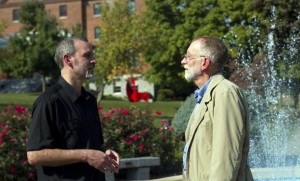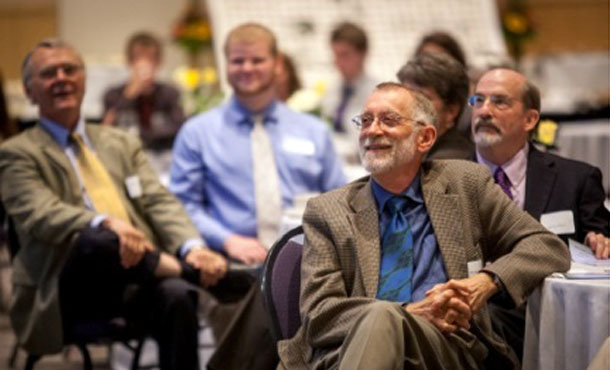More than 100 members of the Virginia Mediation Network (VMN), the state’s largest professional association for mediators and mediation scholars, gathered on campus for a September 28-29 conference co-hosted by the Center for Justice and Peacebuilding (CJP) at Eastern Mennonite University.
Howard Zehr and Carl Stauffer, co-directors of the Zehr Institute for Restorative Justice at EMU, delivered the plenary address, entitled “Putting a Face on the ‘Other.’”
Four days later, Zehr was one of two recipients of the 2013 “Community Service Award,” conferred by the Gandhi Center at James Madison University in a ceremony hosted by JMU President Jonathan R. Alger. The other recipient, Vida S. Huber, was a 1961 graduate of EMU who chaired EMU’s nursing program from 1967 to 1984 and then held leadership roles at JMU until her sudden death in 2005. The awards were given in recognition of the duo’s “visionary leadership and enduring commitment to the creation of a more compassionate, equitable and caring community.” Huber’s surviving husband, Harold, accepted her posthumous award.

Evoking empathetic responses
At the state-wide mediation conference, Zehr and Stauffer, who is a CJP professor, spoke of how a process of “othering” – or increasing the social distance between people or groups – makes it easier for them to harm each other. They then contrasted the ways in which the traditional criminal justice system increases “othering” with the ways that restorative justice processes can reduce social distance and evoke empathic responses between victims and offenders.
Their presentation garnered an enthusiastic response from the audience of mediators, many of whom were hearing specifics about restorative justice’s objectives and techniques for the first time.
“It made a … light bulb go off in my head,” said Doreene Thomas, who wants to start a restorative justice program in Chesapeake, Va., where she mediates cases referred from local courts. “I see a huge need for it.”
Jennifer Phillips, a mediator from Richmond and the VMN president-elect, said the plenary session’s focus on restorative justice opened up a “new world” to her. “I’d heard of restorative justice, but this was the first time I’d been exposed to it like this.
“Hidden treasure”
“I had no idea that [so much] was available here,” Phillips continued, calling EMU “a hidden treasure.”
Zehr and Stauffer also discussed the arts as a good peacebuilding tool for putting faces on “others.” Zehr shared photographs and stories from several of his books intended to humanize prisoners, crime victims and children with incarcerated parents. Stauffer told the audience about a project he worked on in South Africa, where two opposing factions in a violent conflict created films about their experiences. Once the two videos were completed, the two sides combined them into one film exploring the conflict’s roots, which was eventually screened before a mixed audience of people who had previously been unwilling to meet and discuss their differences.
“We think the arts have the power to engage people emotionally and intuitively [in ways] that other things don’t,” said Zehr. “They allow us to engage the ambiguity and complexity of the world.”
Nine CJP-linked presenters
Using the arts as a peacebuilding and conflict resolution tool was the subject of a separate session led by three CJP students – Sarah Roth Shank, Corie Custer and Jonathan Swartz.
Judith Tolleson Clarke, with a 2011 MA from CJP, was one of four panelists who discussed their experiences using “dialogue circles” as part of restorative justice processes within Virginia’s correctional facilities. Clarke, from Richmond, Va., is the executive director and founder of the Virginia Center for Restorative Justice.
Other CJP-affiliated presenters at the conference included professor emeritus Vernon Janzti, who co-led a session on trauma awareness for mediators, Barbie Fischer, a 2012 MA graduate of CJP, who spoke about family group conferencing, and Brenda Waugh, a lawyer from Winchester, Va., who graduated from CJP in 2009. Waugh was co-leader of a session on how the architecture and layout of a room can help or hinder a mediation process.
VMN President Paula Young said one of the reasons she wanted to hold the conference on the EMU campus was to give mediators from the region exposure to the expertise in conflict resolution and peacebuilding resources present at EMU.
“[CJP has] a particularly strong program with particularly strong scholars who can introduce our members to a lot of conflict theory that they might not otherwise get,” she said. “I’ve heard nothing but positive things [from attendees] about being here.”
Shared desire to reduce violence, increase justice
Members of the VMN attended the conference to receive continuing education credits to maintain their certification as mediators, as well as for more informal professional development and networking.
“The sessions have been wonderful,” said Ron Williams, a retired attorney and a relatively new mediator who said the opportunity to learn from more experienced mediators was valuable.
Young said that because some VMN members have long experience as mediators, she wanted to develop a program that would keep them engaged by looking in-depth at challenging and engaging topics – something accomplished by tapping the expertise of the “distinguished scholars” at CJP.
“It was a great pleasure to host the VMN conference on campus,” said CJP professor and program director Jayne Docherty. “The questions and conversation in response to the plenary talk by Howard Zehr and Carl Stauffer indicate that we need to continue our conversation with members of VMN. We seem to have a lot of shared concerns and similar commitments to reducing violence and increasing justice in our communities.”
